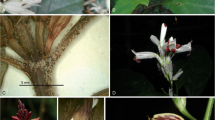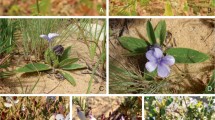Summary
Alpinia sect. Myriocrater of the Philippines is revised here. Alpinia musifolia and A. vulcanica are redescribed using recently collected material from their respective type localities as well as material collected elsewhere in the Philippines. Examination of collections with similar morphology to A. musifolia distributed in the eastern Philippines reveals that the collections represent a new species named here as Alpinia orientalis. Information on their distribution, habitat, and the conservation status of all Philippine Alpinia sect. Myriocrater species are included and a lectotype designated. A key to the Philippine species of Alpinia sect. Myriocrater is provided.







Similar content being viewed by others
References
Bachman, S., Moat, J., Hill, A. W., de Torre, J. & Scott, B. (2011). Supporting Red List threat assessments with GeoCAT: Geospatial conservation assessment tool. In: V. Smith & L. Penev (eds), e-Infrastructures for data publishing in biodiversity Science. ZooKeys 150: 117 – 126.
Burtt, B. L. & Smith, R. M. (1972). Monoecism in Alpinia (Zingiberaceae), with descriptions of six new species. Notes Roy. Bot. Gard. Edinburgh 32 (1): 29 – 43.
De Boer, H. J., Newman, M. F., Poulsen, A. D., Droop, A. J., Fér, T., Lê Thi Thu Hiên, Hlavatá, K., Lamxay, V., Richardson, J. E., Steffen, K. & Leong-Škorničková, J. (2018). Convergent morphology in Alpinieae (Zingiberaceae): Recircumscribing Amomum as a monophyletic genus. Taxon 67 (1): 6 – 36.
Docot, R. V. A., Banag, C. I., Tandang, D. N., Funakoshi, H. & Poulsen, A. D. (2019a). Recircumscription and revision of Vanoverberghia (Zingiberaceae). Blumea 64 (2): 140 – 157.
____, ____ & Poulsen, A. D. (2019b). Reinstatement and revision of the genus Adelmeria (Zingiberaceae) endemic to the Philippines. Taxon 68 (3): 499 – 521.
Elmer, A. D. E. (1919). Zingiberaceae of the Sorsogon Peninsula. Leafl. Philipp. Bot. 8: 2963 – 2995.
Fernando, E. S. (2008). Forest Formations of the Philippines. ASEAN-Korea Environmental Cooperation Unit, Los Baños.
IUCN Standards and Petitions Subcommittee (2019). Guidelines for using the IUCN Red List categories and criteria, version 14. Available from: https://nc.iucnredlist.org/redlist/content/attachment_files/RedListGuidelines.pdf. [Accessed 9 April 2021].
Kress, W., Prince, L. M. & Williams, K. J. (2002). The phylogeny and new classification of the gingers (Zingiberaceae): Evidence from molecular data. Amer. J. Bot. 89 (11): 1682 – 1696.
____, Liu, A.-Z., Newman, M. F. & Li, Q.-J. (2005). The molecular phylogeny of Alpinia (Zingiberaceae): A complex and polyphyletic genus of gingers. Amer. J. Bot. 92 (1): 167 – 178.
____, Newman, M. F., Poulsen, A. D. & Specht, C. (2007). An analysis of generic circumscriptions in tribe Alpinieae (Alpinioideae: Zingiberaceae). Gard. Bull. Singapore 59: 113 – 128.
Loesener, T. H. (1930). Zingiberaceae. In: A. Engler & K. Prantl (ed.), Die natürlichen Pflanzenfamilien, 2nd ed., Vol. 15a: 541 – 640. Engelmann, Leipzig.
Merrill, E. D. (1923). An enumeration of Philippine Flowering Plants, Vol. 1. Bureau of Printing, Manila.
Newman, M. F., Lhuillier, A. & Poulsen, A. D. (2004). Checklist of the Zingiberaceae of Malesia. Blumea Suppl. 16: 1 – 166.
Pelser, P. B., Barcelona, J. F. & Nickrent, D. L. (eds) (2011 onwards). Co’s digital flora of the Philippines. Available from: http://www.philippineplants.org [Accessed 9 April 2021]
Rangsiruji, A., Newman, M. F. & Cronk, Q. C. B. (2000). A study of the infrageneric classification of Alpinia (Zingiberaceae) based on the ITS region of nuclear rDNA and the trnL-F spacer of chloroplast DNA. In: K. L. Wilson & D. A. Morrison (eds), Monocots: Systematics and evolution, pp. 695 – 709. CSIRO Publishing, Collingwood, Vic.
Ridley, H. N. (1909). Zingiberaceae from South Negros. Leafl. Philipp. Bot. 2: 602 – 607.
Schumann, K. (1904). Zingiberaceae. In: A. Engler (ed.), Das Pflanzenreich IV. 46 (Heft 20): 1 – 458. Engelmann, Leipzig.
Shorthouse, D. P. (2010). SimpleMappr, an online tool to produce publication-quality point maps. https://www.simplemappr.net. [Accessed 29 April 2022].
Smith, R. M. (1975). A preliminary review of the large bracteate species of Alpinia. Notes Roy. Bot. Gard. Edinburgh 34: 149 – 182.
____ (1977). Additional notes on Alpinia sect. Myriocrater. Notes Roy. Bot. Gard. Edinburgh 38: 195 – 208.
____ (1990). Alpinia (Zingiberaceae): A proposed new infrageneric classification. Edinburgh J. Bot. 47: 1 – 75.
____ (1991). New species of Alpinia from Sulawesi and Sarawak. Edinburgh J. Bot. 48 (3): 347 – 352.
Thiers, B. (2022, continuously updated). Index Herbariorum: A global directory of public herbaria and associated staff. New York Botanical Garden's Virtual Herbarium. Available at: http://sweetgum.nybg.org/science/ih/ [Accessed 29 April 2022].
Turner, I. M. (2000). The plant taxa of H.N. Ridley, 3. The Zingiberales. Asian J. Trop. Biol. 4 (1): 1 – 47.
Acknowledgements
We thank the curators and staff of the following herbaria for loans and access to their collections: BM, E, K, L, NY, PNH, SING, and USTH; P. B. Pelser and J. F. Barcelona for permission to use their photographs of Alpinia orientalis from Dinagat Islands; A. D. Poulsen for providing photographs of Alpinia sect. Myriocrater species distributed in Sulawesi; G. C. V. Gamus for the drawings; J. A. D. Ordas, N. K. G. Alfeche, C. B. M. Domingo, N. L. Moran, K. D. Gutierrez, R. E. E. Mamalias, N. B. R. Espino, A. A. B. Java, C. D. Dineros, A. J. Mangusad, A. J. Bagay, B. R. Sosa, C. Reyes, T. Chen, ‘Bantay Gubat’ of San Isidro, Davao Oriental and some staff of the National Museum of the Philippines for help during fieldwork; Department of Environment and Natural Resources (DENR) Region V, XI, and XIII as well as the Protected Areas Management Board (PAMB) of Mount Hamiguitan Wildlife Sanctuary, PENRO Davao Oriental, Dinagat Islands, and Sorsogon for the collection permits; the Global Environment Facility (GEF) through the United Nations Environmental Fund (UNEF) with the DENR-Biodiversity Management, Biodiversity Management Bureau (BMB), the Department of Science and Technology (DOST), and Grant-In-Aid for the research grants to D.N.T.; the Philippine Council for Agriculture, Aquatic and Natural Resources Research and Development for monitoring the research of D.N.T.; the Commission on Higher Education DARE-TO research grant to C.I.B.; the University Research Center (URC) of FEU for additional grants to R.V.A.D.; Research Center for Natural and Applied Sciences (RCNAS) and the Far Eastern University Herbarium (FEUH) for the facilities and laboratory equipment.
Author information
Authors and Affiliations
Corresponding author
Additional information
Publisher’s Note
Springer Nature remains neutral with regard to jurisdictional claims in published maps and institutional affiliations.
Rights and permissions
About this article
Cite this article
Docot, R.V.A., Banag-Moran, C.I., Zamudio, S.G.S. et al. A revision of Alpinia sect. Myriocrater (Zingiberaceae) of the Philippines with a description of a new species. Kew Bull 77, 541–553 (2022). https://doi.org/10.1007/s12225-022-10023-6
Accepted:
Published:
Issue Date:
DOI: https://doi.org/10.1007/s12225-022-10023-6




